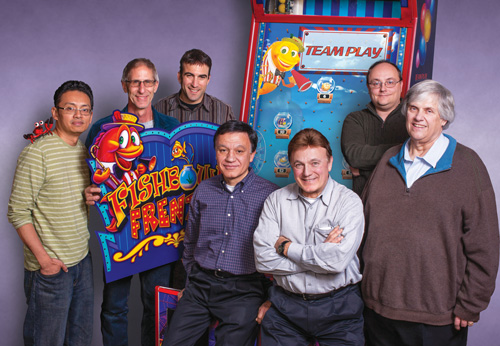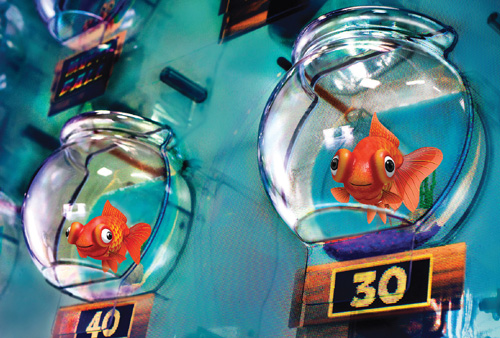News
Fishbowl Frenzy Heralds New Era Of Creative Coin-Op Game Design
March 24, 2015
TAGS: arcade game, Team Play, Fishbowl Frenzy, coin-op game, amusement machine, game design trends, amusement machine engineering augmented-reality, redemption skill game, best new coin-op product, Ken Fedesna, fishbowl toss, carnival game, Bobby Llereza, Pat Cox, Geno Giuntoli, Ed Pellegrini, Frank Pellegrini, Brian Smolik |
ELK GROVE VILLAGE, IL -- Five months after the launch of Team Play's Fishbowl Frenzy, the manufacturer reports that the game has been posting high earnings in many kinds of location, and is attracting players across a broad demographic spectrum. And the novel "augmented-reality" redemption skill game was honored as "best new coin-op product" at the 2014 Attractions Expo (Orlando, FL), organized by the International Association of Amusement Parks and Attractions. It also was a hit at January's European Amusement and Gaming International Expo in London, where it attracted considerable visitor attention at the United Distributing Co. Ltd. exhibit.
Much of the game's appeal results from its tight integration of classic, contemporary and cutting-edge technologies. Each element required the creative application of specialized engineering skill sets to merge disparate technologies seamlessly -- and make it look easy.
The game's concept is based on one of the oldest and best-known carnival attraction themes, enhanced by retention. Entirely familiar is the electromechanical pachinko-like play action. The contemporary dimension is provided by the videogame-style graphics that depict the animated fish that populate the "bowls"; each is rendered in high-quality 3D imagery, with individual personalities and distinctive motion. And the cutting edge is represented by the 65" high-definition translucent LCD that overlays the play area and provides the reality augmentation. Team Play is not the first to apply this relatively new imaging technique in coin-op, but its Fish Bowl Frenzy is the first implementation to integrate it with traditional amusement technology.
Successive Refinement
"We've been working on this thing for three years," said Team Play's Ken Fedesna. "In the last two years we've had a dedicated team working on it."
Fedesna explained that the original concept -- the "fishbowl toss" -- was first to arrive on the drawing board. In its initial planning stages, the project closely followed the traditional horizontal format of the simple carnival game.
"It actually started out with players shooting the table tennis balls to land in the bowls," Fedesna recalled. "But that wasn't working out too well. Then Brian Smolik came up with the idea, 'what if we drop a ball from above?'"
 |
THE TEAM PLAY GUYS:Pictured, from left, are Team Play's Bobby Llereza, Pat Cox, Geno Giuntoli, Ed Pellegrini, Frank Pellegrini, Brian Smolik and Ken Fedesna. |
The next question was how to get the video fish into the three-dimensional bowls. The team explored several possible approaches: they might use individual screens behind each bowl or some form of projection system. "Then we came across this translucent screen," he continued. "It was being used in vending machines, but the cost was prohibitive."
However, today's technology expense closely tracks demand, so the cost was dropping fast. Within months, as applications were found for the screens in other industries with deeper pockets, the cost dropped to a viable range. The lesson is that exotic technology often can be translated into a workable component within reach of manufacturers with smaller customer bases, including the coin-op space.
As work on the project ramped up, additional personnel came on board. A year and a half into the project, Team Play had two programmers, three artists and a trio of electrical engineers, along with mechanical and production staff working on the project. At the end, Fishbowl Frenzy required a 10-person team to bring it to market.
Proof Of Concept
Although operators can immediately appreciate the high revenue that Fishbowl Frenzy generates, the industry benefit is more general. The game represents what engineers call "proof of concept." The notion is that new technology can be effectively, creatively and profitably merged with existing game architectures. In the case of Team Play's effort, that means the long-established disciplines of electromechanical and video design merging with the translucent screen. Whether this concept will be repeated in other games remains to be seen, but Fishbowl Frenzy has shown that it is feasible.
"There is a lot of really high-tech stuff out there right now," Smolik said. "And we in the coin-op industry should be saying, 'Hey, someone came up with this really great technology. How do we take advantage of it?' I believe we're right now on the edge of where coin-op companies start to innovate again."
A Billion Dollar Question
Smolik explained that this renaissance of innovation in coin-op is being driven by necessity. "We have to innovate because we need a way to get people to put down their smartphones and get out of their living rooms," he said. "The reality today is that the phone you're carrying around in your pocket is more powerful and entertaining than a lot of videogames out there."
A coin-op industry veteran who has witnessed years of growth in coin-op, Fedesna understands more than most people how the industry's present, long-running downturn has affected engineering staffing levels. This means that some of the more sophisticated "gee-whiz" components, such as Fishbowl Frenzy's translucent LCD, will have to come from industries with fatter R&D budgets. Back in the day when games were run by transistors, coin-op could fund much of its own innovation. However, it is still difficult to imagine the coin-op industry, even at its peak, developing the translucent LCD, the new generation of ultrathin flexible screens, or even the super active-matrix organic light-emitting diode (AMOLED) touchscreen now used on popular mass-market mobile devices.
 |
FOR REAL?A 65" translucent monitor makes 3D-animated fish and bowls look realistic. |
This is not necessarily a bad thing. Companies like Samsung and Sony, and a range of disparate industries from mobile communications through automotive to display advertising, are well equipped, staffed and funded to do the heavy lifting for technological breakthroughs. Their innovations leave the door open for potential synergies with coin-op, though that door may seem to be barely ajar.
"Truly innovative concepts are what will revitalize the coin-op industry," Team Play's Frank Pellegrini summed up. "Pinball in the 1940s was something that was innovative and strong. It wasn't until the 1980s, when video came in, that the industry flourished again. We need to seek out new technology if we ever want to see the Pac-Man or Pong days come back. Team Play hit a home run with Fishbowl Frenzy, but what that next breakthrough technology will be, well, that's the billion-dollar question."


